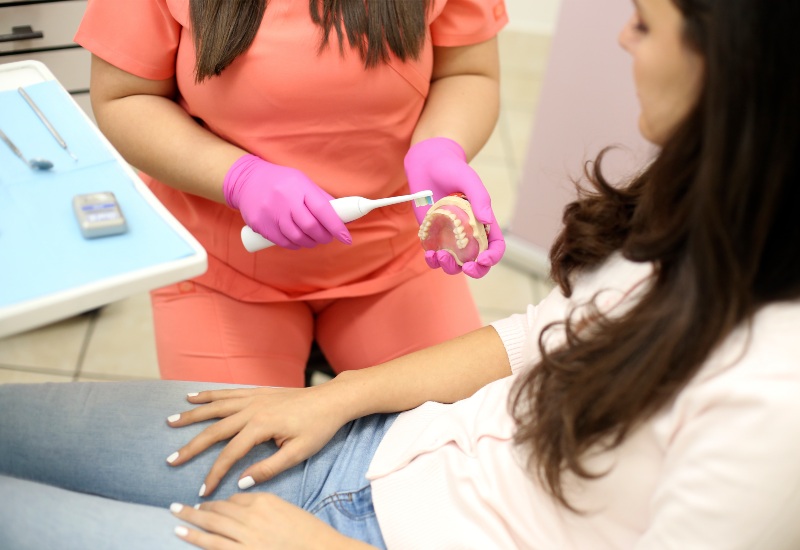Is Your Electric Toothbrush Harming Your Gums Without You Knowing?
How to Use an Electric Toothbrush Safely
Electric toothbrushes are a more convenient way to brush your teeth. However, being overly aggressive with your electric toothbrush can lead to irritation and a receding gumline. The dentist at Family Dental Care helps patients throughout St. Charles and Glen Ellyn, IL understand how to use their electric toothbrush safely. Our dentists are committed to educating our patients to ensure they maintain a healthy and happy smile. Electric toothbrushes are an excellent dental tool for helping to reduce cavities. However, using them safely is essential to minimize potential health risks. If you own an electric toothbrush or are considering purchasing one, continue reading for oral healthcare tips about your electric toothbrush.

What’s an Electric Toothbrush?
An electric toothbrush is a powered dental device that uses rapid, automated bristle movements to clean teeth and gums. Due to its unique design, it’s especially beneficial for individuals with limited dexterity, such as young children and patients with arthritis, to help make brushing easier and more efficient. However, teens and adults can also benefit from using an electric toothbrush. Not every model has the same features. Learn more about the features of an electric toothbrush that make them great for adults and children alike:
- Oscillating or Rotating Heads – The oscillating or rotating head removes plaque and debris more effectively than manual brushing.
- Sonic or Ultrasonic Technology – Some electric toothbrushes use high-frequency vibrations to create fluid dynamics, helping to clean even hard-to-reach areas.
- Built-In Timers – Many models have two-minute timers to ensure you brush long enough. Timers are especially effective for young children who may finish brushing too quickly.
- Multiple Modes – Some electric toothbrushes have numerous cleaning modes, allowing you to better personalize your brush for optimum results.
- Rechargeable – Rechargeable batteries and replacement heads make getting a good clean easier than ever.
Proper Brushing Techniques With an Electric Toothbrush
While electric toothbrushes make brushing easier for patients, they won’t do the job for you. Using an electric toothbrush requires proper technique to clean your teeth and gums thoroughly without causing damage. Are you unsure if you’re using your electric toothbrush properly? Follow our comprehensive, step-by-step guide on how to use an electric toothbrush and experience a visibly brighter smile:
- Prepare Your Brush – Apply a pea-sized amount of fluoride toothpaste to the brush head, then wet the bristles for comfort.
- Hold the Brush at a 45-Degree Angle – Positioning the brush head 45 degrees towards your gumline helps clean both the base and face of your teeth.
- Divide Into Quadrants – Dividing your mouth into four quadrants: upper right, upper left, lower right, and lower left, then spending 30 seconds on each area will ensure each tooth is brushed.
- Move Slowly – Make sure you cover all the surfaces while brushing, including the outer, inner, and chewing surfaces.
- Follow Built-In Timer – Following your electric brush’s built-in timer will ensure you’re brushing for the recommended time.
- Brush Tongue and Roof – Once the timer’s up, brush your tongue and the roof of your mouth to remove bacteria.
- Rinse and Clean – Rinse your mouth thoroughly with water or mouthwash, then rinse the brush head under running water.

Mistakes to Avoid With an Electric Toothbrush
Brushing with an electric toothbrush is highly effective, but certain mistakes can reduce its benefits or even harm your teeth and gums. Avoiding these common mistakes will reduce the risk of cavities, irritated gums, and gum disease:
- Brushing Too Hard – Brushing too hard can irritate your gums and, over time, weaken enamel.
- Not Brushing Long Enough – Most electric toothbrushes have built-in timers to ensure you’re brushing long enough.
- Skipping Hard-to-Reach Places – Brush methodically, ensuring you pay attention to those hard-to-reach areas like your back molars.
- Not Replacing the Brush Head – Replacing the brush head every three months will ensure the bristles can effectively remove food and debris.
- Ignoring the Tongue – Bacteria on the tongue can cause bad breath and contribute to plaque buildup.
What Are the Risks of Using an Electric Toothbrush?
Electric toothbrushes are highly effective. However, misusing it can lead to several risks that harm oral health. If you’re concerned about your electric toothbrush usage, speak with your dentist during your next checkup. They will provide you with instructions on how to avoid these risks:
- Gum Irritation – Brushing too hard or using a scrubbing motion can irritate or damage the gums, leading to gum recession. Don’t ignore the alert if your toothbrush has a pressure sensor.
- Enamel Erosion – Excessive or aggressive brushing can wear down the enamel, making your teeth more susceptible to sensitivity and decay.
- Over-Reliance – Assuming your electric toothbrush will do all the work can lead to neglecting proper technique, resulting in more cavities. Ensure you’re guiding the brush through each quadrant of your mouth and brushing for two minutes.
Are You Ready to Make the Switch to Electric?
The American Dental Association recommends brushing for at least two minutes twice daily to maintain good oral health and protect your teeth from decay. Switching to an electric toothbrush offers numerous benefits, including pressure-sensitivity and brush timers, making it an effective and efficient device for helping to keep your teeth and gums healthy and clean. The dentists at Family Dental Care can assist patients throughout St. Charles & Glen Ellyn, IL, in deciding which electric toothbrush is right for them and provide instruction on how to safely and effectively use their electric toothbrush. Contact our office today to schedule your next appointment.
